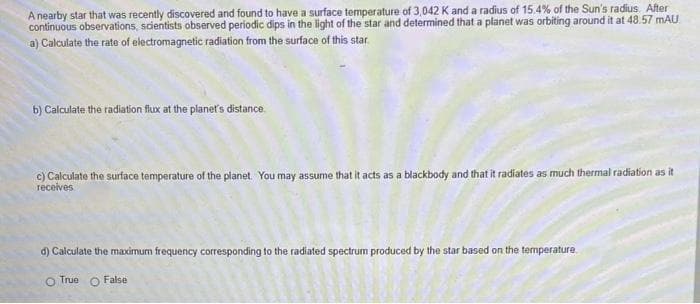A nearby star that was recently discovered and found to have a surface temperature of 3,042 K and a radius of 15.4% of the Sun's radius. After continuous observations, sdentists observed periodic dips in the light of the star and determined that a planet was orbiting around it at 48.57 mAU, a) Calculate the rate of electromagnetic radiation from the surface of this star. b) Calculate the radiation flux at the planet's distance. c) Calculate the surface temperature of the planet. You may assume that it acts as a blackbody and that it radiates as much thermal radiation as it receives
A nearby star that was recently discovered and found to have a surface temperature of 3,042 K and a radius of 15.4% of the Sun's radius. After continuous observations, sdentists observed periodic dips in the light of the star and determined that a planet was orbiting around it at 48.57 mAU, a) Calculate the rate of electromagnetic radiation from the surface of this star. b) Calculate the radiation flux at the planet's distance. c) Calculate the surface temperature of the planet. You may assume that it acts as a blackbody and that it radiates as much thermal radiation as it receives
Physics for Scientists and Engineers, Technology Update (No access codes included)
9th Edition
ISBN:9781305116399
Author:Raymond A. Serway, John W. Jewett
Publisher:Raymond A. Serway, John W. Jewett
Chapter34: Electromagnetic Waves
Section: Chapter Questions
Problem 34.43P: A possible means of space flight is to place a perfectly reflecting aluminized sheet into orbit...
Related questions
Question
B3

Transcribed Image Text:A nearby star that was recently discovered and found to have a surface temperature of 3,042 K and a radius of 15.4% of the Sun's radius. After
continuous observations, sdentists observed periodic dips in the light of the star and determined that a planet was orbiting around it at 48.57 mAU,
a) Calculate the rate of electromagnetic radiation from the surface of this star.
b) Calculate the radiation flux at the planet's distance.
c) Calculate the surface temperature of the planet. You may assume that it acts as a blackbody and that it radiates as much thermal radiation as it
receives
d) Calculate the maximum frequency corresponding to the radiated spectrum produced by the star based on the temperature
O True O False
Expert Solution
This question has been solved!
Explore an expertly crafted, step-by-step solution for a thorough understanding of key concepts.
This is a popular solution!
Trending now
This is a popular solution!
Step by step
Solved in 2 steps with 2 images

Knowledge Booster
Learn more about
Need a deep-dive on the concept behind this application? Look no further. Learn more about this topic, physics and related others by exploring similar questions and additional content below.Recommended textbooks for you

Physics for Scientists and Engineers, Technology …
Physics
ISBN:
9781305116399
Author:
Raymond A. Serway, John W. Jewett
Publisher:
Cengage Learning

College Physics
Physics
ISBN:
9781938168000
Author:
Paul Peter Urone, Roger Hinrichs
Publisher:
OpenStax College

Principles of Physics: A Calculus-Based Text
Physics
ISBN:
9781133104261
Author:
Raymond A. Serway, John W. Jewett
Publisher:
Cengage Learning

Physics for Scientists and Engineers, Technology …
Physics
ISBN:
9781305116399
Author:
Raymond A. Serway, John W. Jewett
Publisher:
Cengage Learning

College Physics
Physics
ISBN:
9781938168000
Author:
Paul Peter Urone, Roger Hinrichs
Publisher:
OpenStax College

Principles of Physics: A Calculus-Based Text
Physics
ISBN:
9781133104261
Author:
Raymond A. Serway, John W. Jewett
Publisher:
Cengage Learning

Physics for Scientists and Engineers: Foundations…
Physics
ISBN:
9781133939146
Author:
Katz, Debora M.
Publisher:
Cengage Learning

Physics for Scientists and Engineers with Modern …
Physics
ISBN:
9781337553292
Author:
Raymond A. Serway, John W. Jewett
Publisher:
Cengage Learning

Physics for Scientists and Engineers
Physics
ISBN:
9781337553278
Author:
Raymond A. Serway, John W. Jewett
Publisher:
Cengage Learning